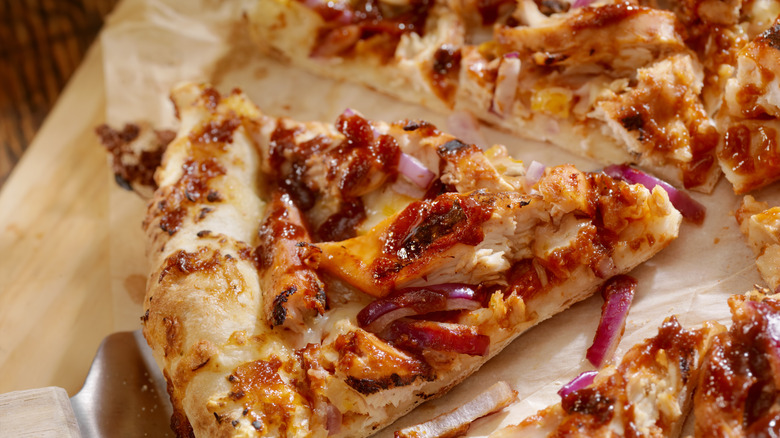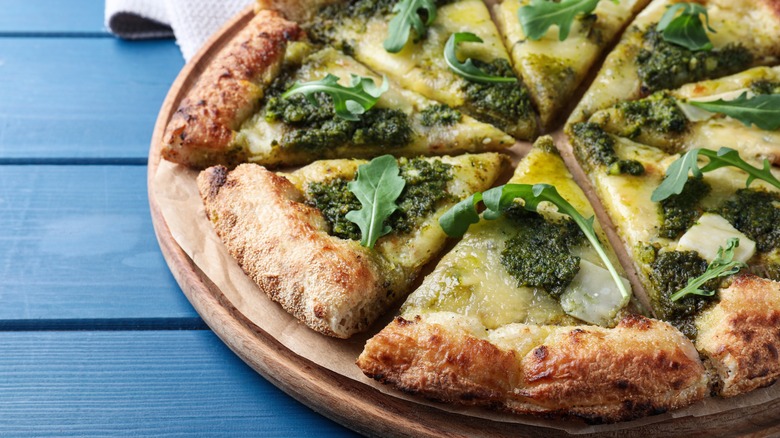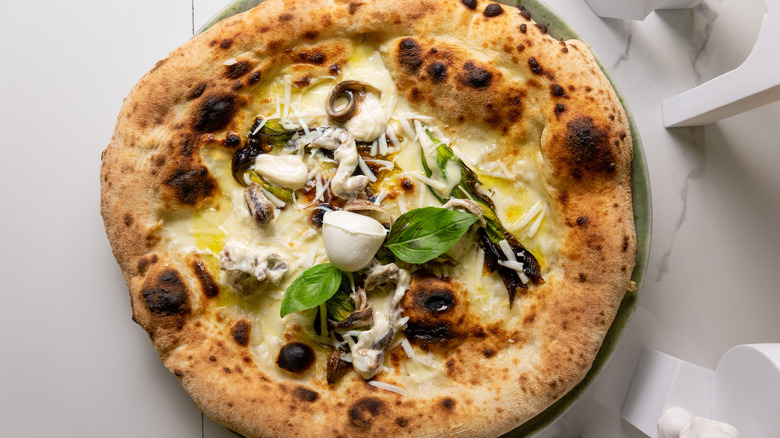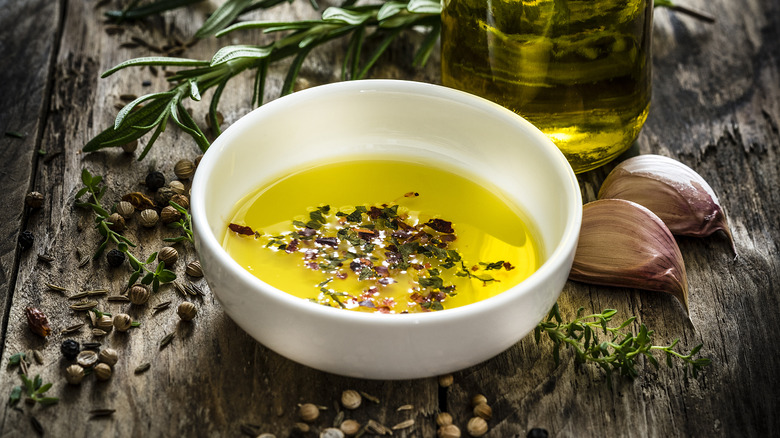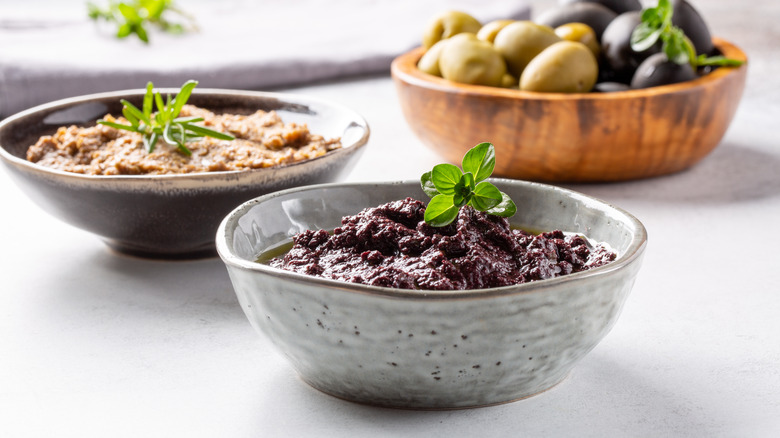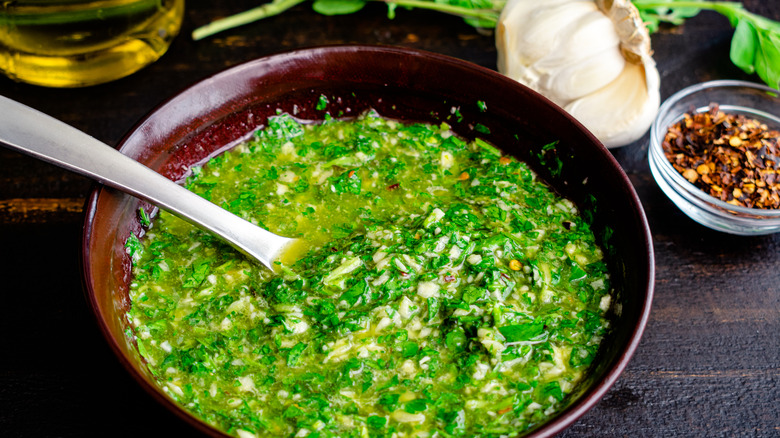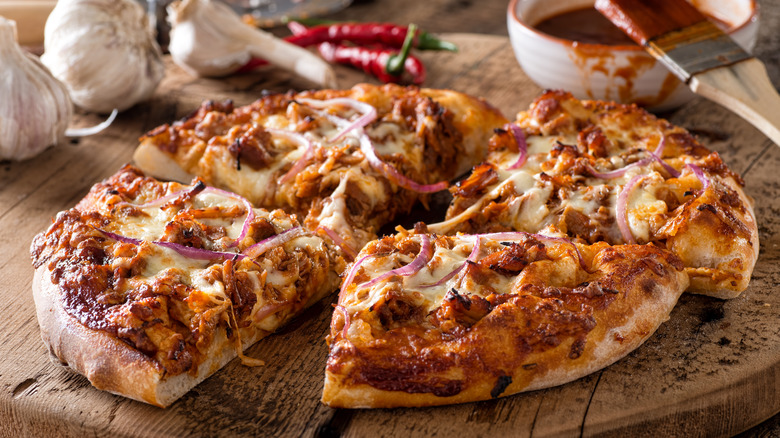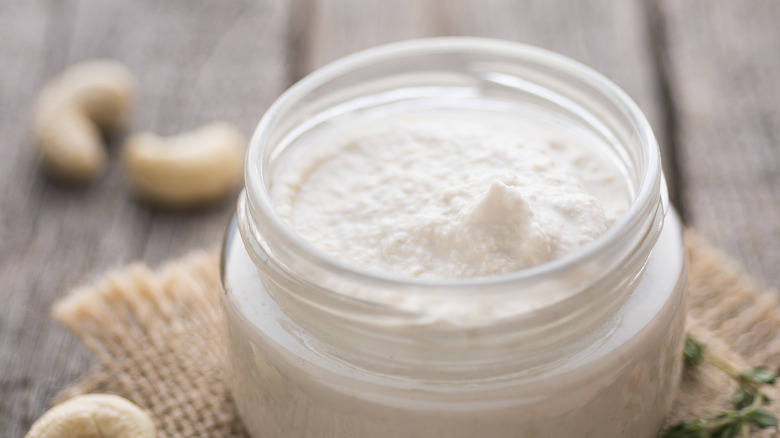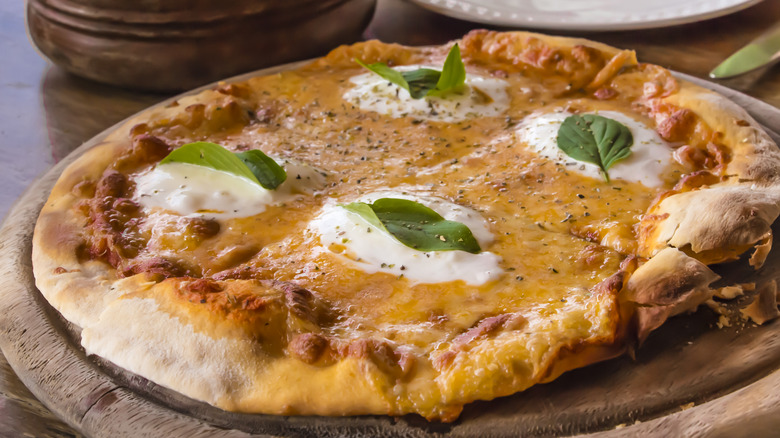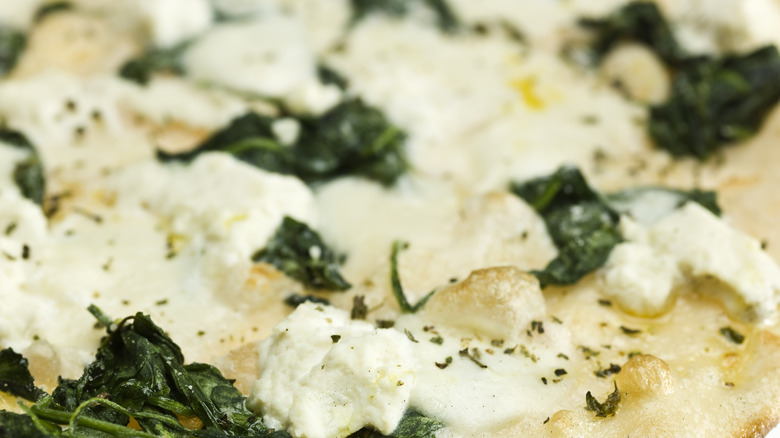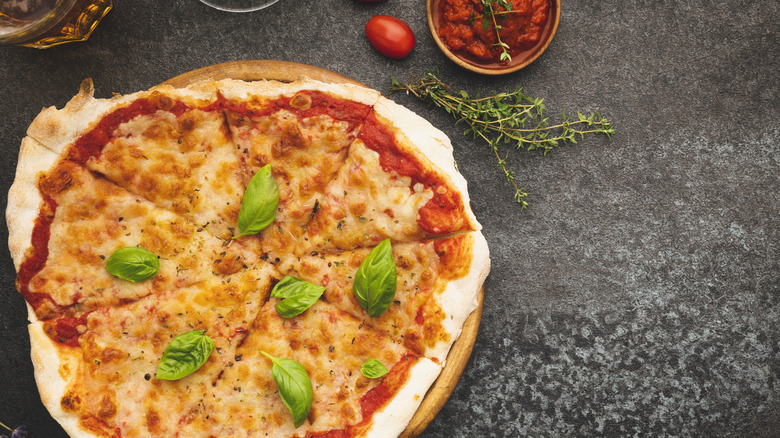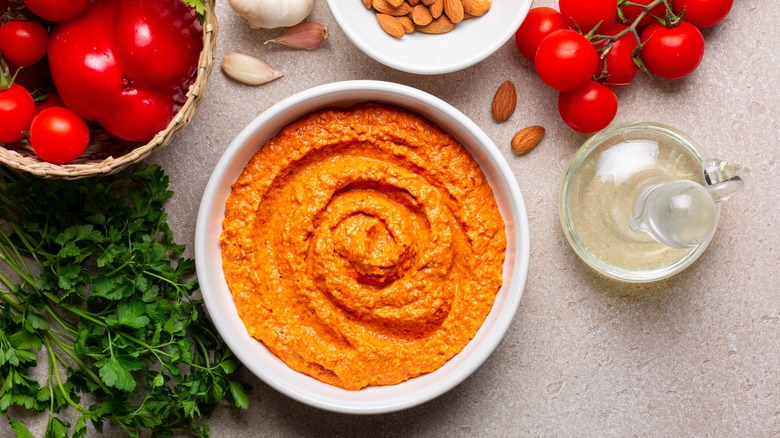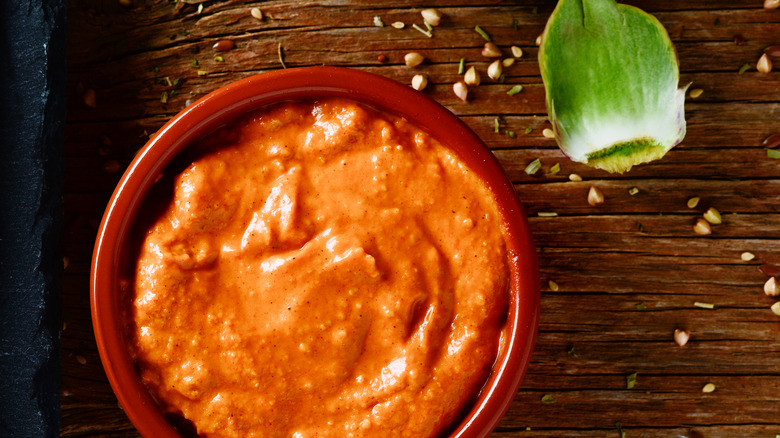12 Delicious Alternatives For Classic Pizza Sauce
Pizza is the king of comfort food, late-night eats, and takeout. In fact, it's hard to find a food that is more universally loved and can be adapted to fit so many palates. From Pizza Hut stuffed-crust double cheese pizzas to an herb-crusted fig-and-balsamic pie topped with brie, this culinary creation has quite a range. And while it's common to enjoy a standard cheese or margherita pizza, it's also important to take the path less traveled and experiment with varying toppings.
When straying from a classic pizza sauce, it's important to choose your herbs, spices, toppings, and cheese with particular consciousness. Yes, you can throw any old meat or veggie on top of a tomato-based pie and it will likely come out scrumptious, but when it comes to alternative sauces, it's best to make a plan. Also, don't be afraid to choose multiple sauces and load on the toppings — as long as they fit your selected flavor profile. There are plenty of alternatives for your next homemade pie.
Pesto
When it comes to Italian sauces that steal the show in the flavor department, look no further than pesto. It's salty, sweet, tangy, and mildly spicy all at once. In order to make basil pesto, you'll need just a handful of ingredients, but each one carries quite a punch. Fresh ingredients are always best and are essential in the herb and aromatic department. Use a food processor to pulse together extra virgin olive oil, fresh basil, pine nuts, minced garlic, and salt until it's slightly creamy but still holds a little texture.
Alternative ingredients include lemon juice, cashews, walnuts, parmesan cheese, nutritional yeast, black pepper, and lemon zest, which one or all will give your pesto a facelift. In fact, the game-changing ingredient you should add to your pesto is none other than capers. They add just enough salt, and tangy flavor to help elevate the sauce.
When adding pesto to pizza, you have three options. You can either smear it right onto the crust, just below the cheese as you would with tomato sauce. You can dollop it on top of the cheese in little pools. Or you can thin it out with olive oil and drizzle it over the cheese after the pizza has been baked. Either way, pesto makes a fantastic alternative to a classic red sauce because it adds magnificent flavor and color and tends to pair well with most classic Italian pizza toppings.
Alfredo sauce
White sauce is actually quite common and can act as a mild alternative that helps mellow toppings to shine. Pre-made béchamel or alfredo sauce can be used, or you can start from scratch and make your own creamy white pizza sauce recipe. And just because this sauce is ultra cheesy, doesn't mean you can't layer on the cheese as well. Simply smear the white sauce on the crust, as you would with a tomato-based pizza sauce, add your cheese, and then load up on toppings.
White sauce pairs particularly well with minimal yet carefully chosen toppings: Focus on ingredients that couple with cheese in other recipes, like spinach and artichoke or parsley and shrimp. Keep things simple and add herbs, olive oil, and garlic to your pie. Try using a variety of mushrooms, or choose salty meat like prosciutto to steal the show. Onions, shallots, and garlic can make a sweet yet mild addition to a white pizza, while fresh ingredients added after baking like arugula can take it to the next level. Consider adding fruits like figs alongside specialty cheeses, and allow them to act as complex and contrasting flavors without being overpowered by the strong umami flavors of a traditional tomato sauce. This is your opportunity to get experimental with ingredients (without creating a confusing and overwhelming the pie).
Garlic-infused olive oil
Sometimes when creating your own flavor profiles for a dish, it's best to stick to simple ingredients, especially when it comes to base flavors. Pizza is no exception. Olive oil can be more than just a fatty plant-based substance to fry your stovetop vegetables in or whisk together a vinaigrette. It carries quite a bit of flavor on its own, especially when you choose a high-quality extra virgin olive oil. Although the flavor of EVOO varies, as it does with wine or coffee, olive oil should have subtle floral, peppery, and fruity undertones. Spring for the freshest bottle you can get for a stronger flavor.
Mix your olive oil with minced garlic or oven-roasted garlic that's been mashed into a paste. Add herbs like freshly minced basil, oregano, and parsley. Hot pepper flakes, black pepper, and sea salt can help to elevate the overall flavor. Used dried aromatics like garlic powder and onion powder, or add a little lemon zest and parmesan cheese to add bite-y undertones. There are endless ways to flavor olive oil, but even just a drizzle of EVOO mixed with garlic can go a long way.
Drizzle it over your dough, and choose fresh and light cheeses and ingredients to top the pizza. You can never go wrong with an herby, garlicky base with a rich and fatty mouthfeel.
Tapenade
Ever had tapenade spread lightly on crostini, dolloped onto a pasta dish, or used to enhance the flavor of fish or meat? If you have then you know it's quite powerful in flavor and helps to enhance the saltiness of any dish. But what is olive tapenade actually made of? Typically, it's made with a base of minced olives and capers. It can be made with either dark or light olives, but whichever direction you choose, they should take center stage.
Some tapenade includes anchovies, so be sure to alert any vegetarians or folks with seafood allergies if you choose to add this ingredient which carries an undertone of umami. Aromatics are often included as well, like garlic, shallots, or onion. Herbs and spices aren't always part of the equation, but certainly help to add a variety of flavors. The last ingredient is olive oil, to bring the spread to a perfect consistency, and add a fatty mouthfeel. If this all sounds appealing to you, then you should consider spreading tapenade on your pizza as an alternative to classic pizza sauce.
When spreading tapenade on your pie, keep in mind that it's quite intense and salty. Use just a thin layer, so that you can still see most of the dough through the spread. Avoid uber-salty cheese or intensely salty toppings to avoid overkill for your creation.
Chimichurri
If you're looking for a unique spin on pesto with a South American kick, then look no further than chimichurri. A fresh chimichurri sauce recipe is typically made with minced fresh herbs and a base flavor of parsley. It can also contain cilantro, chives, and other herbs. In addition, chilis, vinegar, olive oil, and garlic are added to the mix for flavor. It's typically thinner than pesto and makes for more of a drizzle than a paste. It's also tangier because of the addition of vinegar, which provides a nice balance. Sometimes additional aromatics like onions and shallots are included. Ingredients like lemon juice or lemon zest help elevate the tangy and refreshing undertones.
Because Chimichurri typically pairs well with South American cuisine, it's important to choose toppings accordingly. It's intense, and lightly spicy, so a nice mellow cheese can help to balance the heat. Choose ingredients from south of the border like roasted corn, avocado, onions, bell peppers, peppers, and even refried beans. Use chimichurri between the dough and the cheese but also reserve some to drizzle on top for garnish and additional flavor.
Barbecue
Even for Americans who tend to not wander outside of their comfort zone when it comes to classics like pizza, it's likely that you've still encountered a barbecue sauce pizza a time or two in your life. Barbecue sauce adds a savory sweetness, typically with subtle smokey and spicy undertones. It's tangy, bold, and will certainly change the entire composition of your pies flavor profile. That's why it's so important to be selective about toppings when creating your theme when using barbecue sauce.
If you don't have a bottle of the sauce on hand, try making a quick barbecue sauce at home using ingredients you may already have in the refrigerator. Mix together ketchup, white vinegar, brown sugar, garlic and onion powder, paprika, Worcestershire, and olive oil.
Both mild and sharp cheese like mozzarella and aged cheddar pair well with barbecue sauce. Southwestern and sweet toppings also tend to be complementary. Try using roasted corn, sweet red onion, Swiss chard, pineapple (although it's controversial as a pizza topping), or red peppers to lean into the sweetness. Balance the sugars with chicken, mushrooms, or pork. Use just a light drizzle of the sauce, either below the cheese, or on top of it for a nice aesthetic appeal. Green onion and fresh cilantro can make for beautiful garnishes after the pie begins to cool.
Cashew cream
Who says vegan pizza can't contain a creamy component besides the standard vegan cheese? We love a good white pizza, and those who don't consume dairy shouldn't have to miss out on all the fun. While cashew cream may seem like an intimidating feat to make from scratch, think of it as a learning experience, as it can come in handy with cooking across the board, whether you're dairy-inclusive or not in your recipes. Adding cashew cream is one of the top tips for making a flavorful vegan pizza, so it's time to dive in head first.
Start with raw, unsalted cashews and soak them overnight. If you're impatient or crunched for time, soak them in warm water until they break apart easily when squeezed, which should take no more than 30 minutes. Blend those nuts with lemon juice, salt, a dash of sweetener, and enough water to cover. Feel free to add flavors like roasted garlic, dijon mustard, nutritional yeast, and hot pepper flakes to really make it sing.
Smear your cashew cream on the dough before adding vegan or dairy cheese and other toppings. The cashew cream will reduce as it's heated. Cashew cream, when flavored properly, can also act as a cheese topping, and can even be drizzled over veggies or meats. Consider adding cashew cream to any pizza, but especially those with flavorful toppings like onions, corn, broccoli, and mushrooms. Pair with another sauce like barbecue, buffalo, or balsamic reduction if desired.
Buffalo sauce
If you're one of those people who carries around a little bottle of hot sauce with you wherever you go, then consider using buffalo sauce as an alternative to classic pizza sauce. In particular, buffalo sauce is quite intense with both spicy and vinegar punches of flavor that can dominate a dish. That's why it's extra important to be selective when choosing toppings, and it's essential not to go overboard with a variety of flavors. Even if you opt for a store-bought brand, you can give your buffalo sauce a flavor punch with a bit of garlic. Use freshly minced garlic, roasted garlic, or garlic powder as a mix-in.
Use just a thin layer of buffalo sauce on your dough, but reserve some for drizzling on top of the cheese. Anyone choosing buffalo sauce for their pizza clearly enjoys intensity, so lean into it by choosing a punchy cheese like blue cheese or gorgonzola. Try to include as much creaminess as you can to help mellow out the spice, so adding cream cheese or mozzarella may create balance. Onions, chicken, blue cheese dressing, ranch dressing, and tofu can complement the buffalo sauce, while not competing with its intensity. Garnish your pie with green onion or cilantro.
Ricotta cheese
While most of our suggested delicious alternatives for classic pizza sauce are sauces themselves, consider using ricotta cheese in its place instead. Now, this doesn't necessarily mean that the cheese is replacing both the sauce and the cheese components. Spread ricotta abundantly onto your herbed dough and top with a cheese of your choice. Luckily, ricotta is creamy, light, and rather mild so most cheeses tend to complement it well. You can also choose to have ricotta replace both your sauce and cheese, which can broaden your horizons when it comes to selecting toppings.
When using ricotta as a sauce and cheese, consider going out of your comfort zone and topping your pizza with fruit as a breakfast or dessert pie. You can do the same thing with cream cheese and even drizzle the final creation with honey or maple syrup to really drive the sweetness home.
If that's not your thing, make a cheesy, earthy vegetable pizza, loaded with fresh favorites like chard, zucchini, and oyster mushrooms. Sweet mild vegetables like caramelized onions complement the refreshing cheese well, as well as herbs like basil and sage. Consider keeping the toppings simple, so perhaps not exceeding three or four in order to allow the fresh and mild flavors of the ricotta to shine through.
Arrabbiata
If you like to crank up the heat but love a classic marinara sauce, then it's time you discovered the wonders of arrabbiata sauce. It's made with traditional red sauce ingredients like San Marzano tomatoes, onion, garlic, herbs, and olive oil, but with a kick. Yes, you may already add a dash or two of the red pepper flakes, the simple ingredient that makes arrabbiata sauce so iconic. But arrabbiata calls for quite a bit more. In fact, the heat can be overpowering to those who typically don't cook with a lot of heat. Just keep in mind that the longer the sauce sits, the more the red pepper flakes will blossom and infuse.
Consider using arrabbiata sauce in place of classic pizza sauce on your next pie. It has essentially the same flavor profile, it's just quite a bit spicier, so keep that in mind when selecting cheese. Traditional mozzarella helps to mellow out the spicy kick, but other soft cheeses can work as well. Slices of burrata, dollops of ricotta, and even a little cottage cheese can soften the blow. Load on your vegetable and meat toppings, keeping in mind that if you've maxed out your heat level, you may want to avoid spicy peppers or spicy meats. Strong vinegar flavors can also intensify the heat if that's something you enjoy. In that case, consider banana peppers or marinated vegetables.
Romesco
While romesco might look like a creamy tomato sauce, it's actually quite different. Romesco does contain some similar ingredients like tomato, garlic, herbs, and olive oil, but is made with roasted red peppers and almonds. The peppers provide sweetness, while the almonds make the sauce extra creamy, almost like a red pesto. Vinegar is also added for a little extra tang of flavor, and you can opt to up the red pepper profile by adding paprika. This light orange, sweet sauce makes for a delicious pizza sauce alternative and pairs particularly well with Italian classics, making it easy to work with.
Make your own smokey romesco sauce and load on the mozzarella, cheese, or blend of your choice. Feel free to just add a few slices or dollops of cheese, as the romesco sauce already carries a pleasing creaminess. Toppings like olives and capers can bring a salty punch, while umami flavors like mushrooms and parmesan cheese can help add complexity. Consider mild and tender ingredients like spinach, artichokes, zucchini, zucchini flowers, and onions to allow the romesco to shine through.
When in doubt, load on the roasted yellow and orange peppers. In this case, you cannot have too much of a good thing. Top your creamy pizza with fresh arugula or herbs and drizzle with a balsamic reduction to round out the sweetness and tanginess of the romesco.
Muhammara
While romesco is a popular Spanish sauce, the Syrians developed a similar sauce called Muhammara. So, what is the difference between romesco sauce and muhammara sauce? Well, although the two use red bell peppers, olive oil, and garlic, muhammara sauce also includes a kick with chili peppers, uses walnuts instead of almonds for a meatier flavor. Muhammara also includes pomegranate molasses for additional sweetness, which makes it much sweeter and less tangy. In addition, a typical muhammara sauce does not contain tomatoes, which is a key ingredient in romesco.
This robust and sweet sauce complements pizza beautifully because while it's incredibly unique in flavor, the texture and aesthetic seem to blend right in. And although it's dryer and thicker than a traditional tomato sauce, this only increases the heartiness of the overall pie. If it's too thick, consider thinning it out with additional olive oil. Pair with sweet ingredients like figs or pomegranate seeds, along with balsamic reduction. And when it comes to cheese, the world is your oyster. This sauce is quite hearty, so keep in mind that delicate toppings may get lost in the sauce but are still worth considering.
